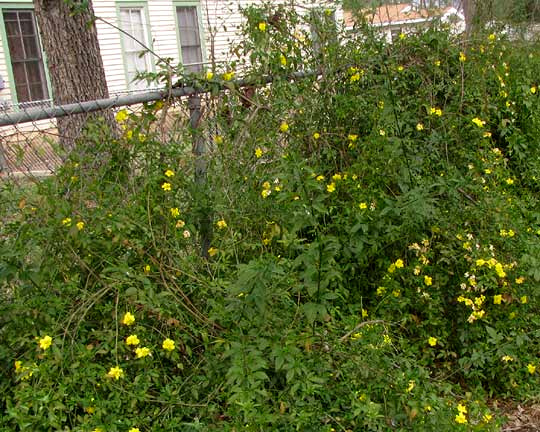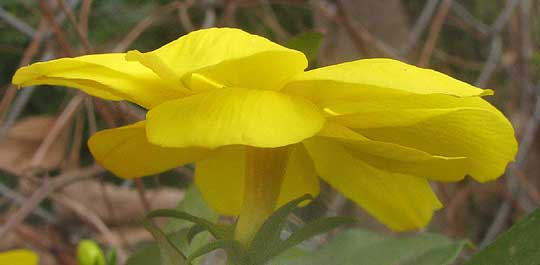Excerpts from Jim Conrad's
Naturalist Newsletter

from the March 9, 2014 Newsletter issued from the Frio Canyon Nature Education Center in the valley of the Dry Frio River in northern Uvalde County, southwestern Texas, on the southern border of the Edwards Plateau; elevation ~1750m (~5750 ft); N29.62°, W99.86°; USA
PRIMROSE JASMINE
On a backstreet in Uvalde, on the same chain-link fence that had Texas Nightshade growing through it, but a little farther down the sidewalk, a viny shrub, or shrubby vine, overgrew the fence and put on a show with its brightly yellow, 1½-inch broad (4cm) flowers, shown below:

The attractive blossoms were curiously "semi-double," meaning that there appeared to be more corolla lobes than there should be -- normally four or five on this kind of flower -- yet they weren't as numerous as, say, on a typical garden rose or marigold. You can see what that looks like at the top of this page.
In that picture notice that the corolla lobes bear orangish lines serving as "nectar guides" for pollinators coming in for a landing. A side view showing the unusual way the lobes are stacked atop one another is seen below:

This rambling shrub was woody, with stiff, straight stems that were squarish in cross-section, and the evergreen leaves were opposite (two to a stem node) and divided into three leaflets, or trifoliate, as shown below:

I'd never met this plant. However, with its flowers containing only two stamens each, and with its opposite leaves, I figured it was a member of the Olive Family, the Oleaceae. Doing an image search on the keywords "Oleaceae yellow trifoliate," the plant's identity came up pretty fast. It's the Primrose Jasmine, or Japanese Jasmine, JASMINUM MESNYI, which despite its Japanese name is a native of western China. However, being in the genus Jasminum, it's a "real jasmine," though not the jasmine.
Primrose Jasmine's blossoms were pleasantly fragrant but not to be compared to the tropical jasmines we've swooned over, though maybe in warmer weather they would have been stronger. On the Internet you can find pictures of the plant admirably forming high, impenetrable walls of herbage and flowers, so gardeners willing to provide support and tend the plants can create amazingly rank, pretty and fragrant barriers perfect for absorbing traffic noise and blocking views.
The FloriData.Com website describes Primrose Jasmine as "one of the best jasmines for the Deep South, especially on sandy soils. It can be disappointing in zone 8 when late spring freezes kill back the new growth. This jasmine is especially useful in the landscape because it is evergreen."